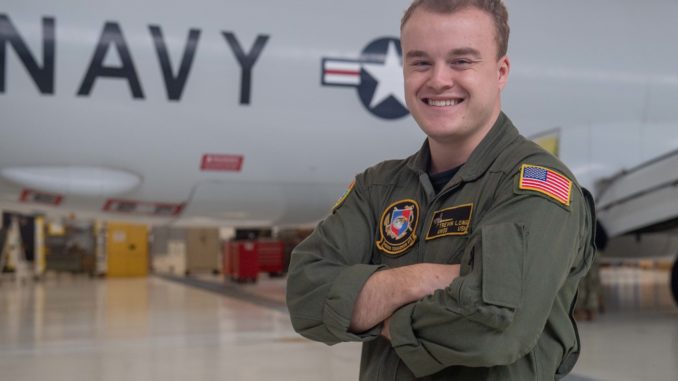
By Mass Communication Specialist 2nd Class Jackson G. Brown,
Navy Office of Community Outreach
Petty Officer 3rd Class Trevin Long, a native of Loveland, Colorado, wanted to serve his country.
 |
| Photo by Mass Communication Specialist 3rd Class Emilia Hilliard |
“I live in a country that provides everything for me already, so I wanted to give something back in return and felt like the Navy gave me the best chance to do that,” said Long.
Now, two and a half years after joining the Navy, Long serves with the “Golden Swordsmen” of Maritime Patrol and Reconnaissance Squadron (VP) 47, working with the Navy’s cutting-edge maritime patrol and reconnaissance aircraft at Naval Air Station Whidbey Island, Washington.
“This is the best squadron I could ask for,” said Long. “The chain of command really cares about our quality of life, and they care about us as both sailors and people. Everyone helps each other the best they can, and there’s no division of jobs and personality. We all have the same goal, and we all get that idea more than most.”
Long, a 2015 graduate of Loveland High School, is a naval aircrewman with VP-47, a high-tech maritime patrol and reconnaissance squadron tasked with monitoring the world’s oceans in the state-of-the-art P-8A “Poseidon.”
“I have a very different job from most other enlisted rates in the Navy,” said Long. “I fly with the aircraft and help track submarines, and basically act as the eye in the sky for the Navy.”
Long credits success in the Navy to many of the lessons learned in Loveland.
“Being involved in a lot of sports growing up, I was always held accountable for my actions, and learned the values of honor and teamwork, as well as leadership,” said Long. “These have all been important to my time in the Navy.”
VP-47’s primary mission is to conduct maritime patrol and reconnaissance as well as long-range anti-submarine warfare, anti-surface warfare, and intelligence gathering missions. They deploy around the world to monitor the world’s oceans wherever they are needed.The P-8A Poseidon, the Navy’s newest maritime, patrol and reconnaissance aircraft, is a replacement aircraft for the legacy P-3C “Orion”. According to Navy officials, leveraging the experience and technology of the successful P-3C “Orion” with the needs of the fleet, the P-8A is designed to be combat-capable, and to improve an operator’s ability to efficiently conduct anti-submarine warfare; anti-surface warfare; and intelligence, surveillance, and reconnaissance missions.
As the Navy transitions to the full capacity with the P-8A “Poseidon”, the aircraft continues the workhorse tradition established by the P-3C “Orion”. The P-8A has a planned state-of-the-art open architecture mission system and next-generation sensors. These capabilities give warfighters added protection. The aircraft empowers the fleet with more combat capability, responsiveness, and interoperability with traditional manned forces and evolving unmanned sensors. The P-8A “Poseidon” has significant growth potential, with planned, phased-in technological improvements that extend global reach, payload capacity, and higher operating altitude.
“It’s the most capable aircraft in the Navy,” said Long. “It can complete just about every mission that the Navy asks of it, and it performs those missions really well. We’re the jack of all trades with the P-8.”
Serving in the Navy means Long is part of a world that is taking on new importance in America’s focus on rebuilding military readiness, strengthening alliances and reforming business practices in support of the National Defense Strategy.
A key element of the Navy the nation needs is tied to the fact that America is a maritime nation, and that the nation’s prosperity is tied to the ability to operate freely on the world’s oceans. More than 70 percent of the Earth’s surface is covered by water; 80 percent of the world’s population lives close to a coast; 90 percent of all global trade by volume travels by sea.
“Our priorities center on people, capabilities, and processes, and will be achieved by our focus on speed, value, results and partnerships,” said Secretary of the Navy Richard V. Spencer. “Readiness, lethality and modernization are the requirements driving these priorities.”
Though there are many ways for sailors to earn distinction in their command, community, and career, Long is most proud of completing his first deployment.
“I went straight to deployment from aircrew school so I was very new, but I was able to pick it up really quick,” said Long. “It was the first time I got to do my job in a situation where it really mattered, and it was very rewarding being able to achieve our goals.”
As a member of one of the U.S. Navy’s most relied-upon assets, Long and other sailors know they are part of a legacy that will last beyond their lifetimes contributing to the Navy the nation needs.
“Serving in the Navy means the world to me, and I’m very proud to be where I am now,” said Long. “I hold myself to a high standard. Not everyone does what we do, so we really respect each other because we did it. We’re one of the largest teams in the world, and we always find ways to succeed.”
Support Northern Colorado Journalism
Show your support for North Forty News by helping us produce more content. It's a kind and simple gesture that will help us continue to bring more content to you.
BONUS - Donors get a link in their receipt to sign up for our once-per-week instant text messaging alert. Get your e-copy of North Forty News the moment it is released!
Click to Donate
